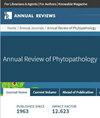寄生植物与寄主之间的分子对话。
IF 9.1
1区 农林科学
Q1 PLANT SCIENCES
Annual review of phytopathology
Pub Date : 2019-08-25
Epub Date: 2019-06-21
DOI:10.1146/annurev-phyto-082718-100043
引用次数: 59
摘要
寄生植物通过吸器连接从寄主植物那里窃取糖、水和其他营养物质。几种寄生植物,如独脚金(Striga属)和帚花(orobche和Phelipanche属)是农业生产的主要生物限制。与其他主要类型的植物病原体相比,寄生植物的研究不足,但最近基因组和转录组学数据的可用性加快了发现植物寄生分子机制的速度。在这里,我们回顾了寄生植物如何感知寄主植物、发芽、形成寄生吸器连接和抑制寄主植物免疫反应的现有知识。此外,我们评估了寄生植物是否符合当前用于理解微生物植物-病原体相互作用的分子机制的范式。最后,我们讨论了寄生植物研究面临的挑战,并提出了最迫切需要回答的问题,以促进我们对植物寄生的理解。本文章由计算机程序翻译,如有差异,请以英文原文为准。
Molecular Dialog Between Parasitic Plants and Their Hosts.
Parasitic plants steal sugars, water, and other nutrients from host plants through a haustorial connection. Several species of parasitic plants such as witchweeds (Striga spp.) and broomrapes (Orobanche and Phelipanche spp.) are major biotic constraints to agricultural production. Parasitic plants are understudied compared with other major classes of plant pathogens, but the recent availability of genomic and transcriptomic data has accelerated the rate of discovery of the molecular mechanisms underpinning plant parasitism. Here, we review the current body of knowledge of how parasitic plants sense host plants, germinate, form parasitic haustorial connections, and suppress host plant immune responses. Additionally, we assess whether parasitic plants fit within the current paradigms used to understand the molecular mechanisms of microbial plant-pathogen interactions. Finally, we discuss challenges facing parasitic plant research and propose the most urgent questions that need to be answered to advance our understanding of plant parasitism.
求助全文
通过发布文献求助,成功后即可免费获取论文全文。
去求助
来源期刊

Annual review of phytopathology
生物-植物科学
CiteScore
16.60
自引率
1.00%
发文量
19
期刊介绍:
The Annual Review of Phytopathology, established in 1963, covers major advancements in plant pathology, including plant disease diagnosis, pathogens, host-pathogen Interactions, epidemiology and ecology, breeding for resistance and plant disease management, and includes a special section on the development of concepts. The journal is now open access through Annual Reviews' Subscribe to Open program, with articles published under a CC BY license.
 求助内容:
求助内容: 应助结果提醒方式:
应助结果提醒方式:


